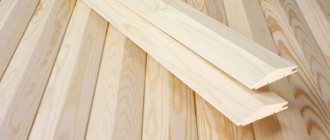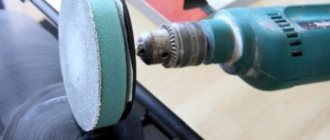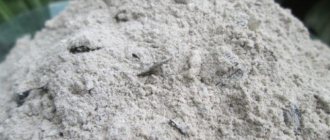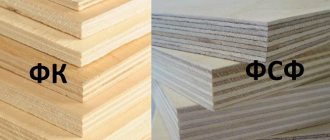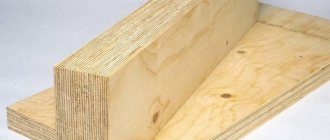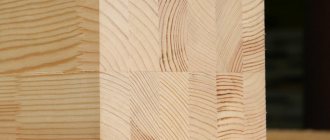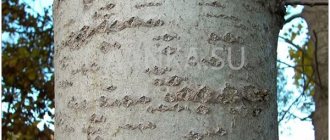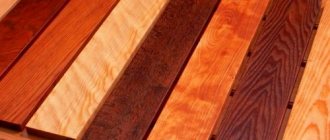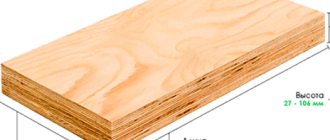Wood in interiors is often used without painting with colored paints and enamels. The natural color and bright texture of the fibers look much more attractive than a single-color fill. However, to preserve the natural color, it is necessary that the coating be as natural as possible and not dull the beauty and naturalness of the material. You can preserve all the beauty of wood using special surface coating methods, one of which is wood waxing. Waxing wood is one of the most ancient methods of protecting wood that has survived to this day. Today, the use of natural products based on natural materials is gaining increasing popularity due to the availability and simplicity of technology and the use of new formulations based on beeswax.
Types of natural wax
The properties and effectiveness of wax products vary depending on the type and origin of the components of the composition, as well as the presence of additional ingredients in it.
- Soft wax penetrates deeper than others, but has the weakest protective properties.
- It melts under the influence of heat and requires constant renewal.
- After treatment with soft wax, wood acquires a characteristic matte shine, but the product does not repel dust.
Hard waxes dry faster after treatment, fill minor scratches, and provide protection against mechanical damage. They form a reliable water-repellent coating, protect the surface from contamination and the effects of various coloring liquids (juice, wine, tea).
Recipe with added wax
The simplest option is wax impregnation without the use of a solvent, which will give the wood a pleasant silky shine. You will need:
- 100 grams of flaxseed oil;
- 4 grams of beeswax;
- 2 grams of carnauba wax.
Heat the oil to 90 degrees and add wax. Stir the mixture until the wax is completely dissolved. The resulting impregnation should not be too thick, but not too liquid. Wax oil is thixotropic - in a calm state it becomes viscous, but if you shake the container, the impregnation will become more liquid.
Benefits of wax formulations
Wax is used in a variety of areas: industry, medicine, cosmetology, household. The main advantage of the natural composition of wax products is its complete safety. It does not contain toxic impurities, so it can be used in any room, including a children's room.
Advantages of waxing wood:
- Strengthening wood fibers;
- Improving the appearance of products;
- Fire resistance – wax is not subject to combustion and does not emit hazardous substances, but at high temperatures the surface treated with wax may become deformed;
- Moisture resistance - effectively repels steam and water droplets, preventing wood from getting wet and the development of mold and mildew.
Thanks to its natural chemical composition, wax is not subject to oxidation, therefore it retains its protective properties for a long time. After treatment with wax, the wood does not change color for many years.
Treating wood with wax creates a hard, yet thin, breathable coating that increases resistance to wear, simplifies maintenance, and prevents rot.
Wax products allow you to give wood shine and pleasant smoothness, highlight its beautiful texture, and make the natural pattern more contrasting.
TOP best means
The TOP includes only the best materials with optimal characteristics.
Gappa matte, 0000 colorless
High quality material that can be used for both indoor and outdoor use. This allows the product to be used, including for garden furniture. The product provides reliable protection against aggressive biological environments, the harmful effects of moisture and ultraviolet radiation.
Characteristics:
- processing material – wood;
- hardening time – 24 hours;
- UV protection – yes;
- minimum consumption – 30 sq.m/l;
- gloss level – matte;
- shelf life – 5 years.
Advantages and disadvantages:
- reliable protection;
- faint odor;
- ease of application;
- low consumption;
- high quality;
- wear-resistant attractive coating.
- long drying time.
BIOFA hard professional, matte
High quality material recommended for all types of wood. Suitable for interior work, including processing wooden furniture in a children's room. Forms a water- and dirt-repellent coating on the surface. It is easy to use.
Characteristics:
- processing material – wood;
- hardening time – 24 hours;
- gloss level – matte;
- type of coating – glaze;
- shelf life – 2 years.
Advantages and disadvantages:
- fits well on the surface;
- ease of use;
- can be applied in several layers;
- reliable protection of wood from external negative influences.
- takes a long time to dry;
- a pungent odor that can cause dizziness and headaches.
OSMO TopOil, 3058 clear matt
A high quality product that is recommended for use for interior work. It is safe to use. Does not emit toxic fumes and does not cause allergic reactions. Thanks to this, the material can be used for interior items in a children's room.
Characteristics:
- processing material – wood;
- hardening time – 24 hours;
- gloss level – matte;
- type of coating – glaze;
- shelf life – 5 years.
Advantages and disadvantages:
- good to go to bed;
- high quality;
- suitable for furniture in children's rooms;
- restores the external attractiveness of interior items;
- reliable protection from external negative influences.
- There are no cons.
Oil-wax is a material that creates a protective coating on wooden furniture. Expert advice and TOP best products will help you choose the right product.
Wax mastics
Mastics are made on the basis of natural wax, often containing turpentine, drying oil, rosin, and stearin. Working with mastic will require special experience and skill - processing large areas is quite difficult. In addition, when heated and absorbed into wood, product consumption increases.
Features of application: This mastic must be preheated so that it penetrates more deeply into the structure. After treatment, the surface must be polished.
Oil with wax for interior work: what to look for when choosing
To choose the best wood oil for interior work, you should pay attention to the following parameters:
- composition of components - give preference to oil-to-wax for interior work, made from natural plant waxes, which are more refractory and durable than beeswax; be careful when choosing products containing potential allergens, for example, orange oil;
- type of wood - oil with wax for interior work is available for various types of wood;
- features of the type of coating - oils with wax for interior work can have different color shades, from white to dark, degree of gloss, differ in their characteristics and application features, as well as drying time.
OSMO HARTWACHS OL EFFECT SILVER/GOLD oil is especially popular among customers.
A hard wax product intended for decorative finishing of dark woods, containing metallic pigments. HARTWACHS OL EFFECT SILVER/GOLD oil gives the wood surface a presentable appearance, providing the effect of a silver/golden glow. The product consists of components of natural origin. The quality of OSMO oil is confirmed by relevant safety certificates. The product is optimal for application to wooden floors or furniture surfaces.
Waxes with oils
To provide the tree with the most reliable protection, it is impregnated with oil before applying wax. Professional formulations can significantly simplify the processing process.
For example, products from OSMO contain oils and waxes, so they retain all the properties of a natural product:
- Penetrates well into the wood structure and provides deep protection;
- Even after damage to the protective layer, moisture penetration inside is limited;
- Preserves the elasticity of wood and reduces the risk of drying out;
- Prevents the development of mold and pathogens;
- Protect the tree from waterlogging.
In addition to vegetable oils and waxes, the composition includes water-repellent additives. Processing allows you to enhance the natural color of wood or give it a light shade with the addition of pigments.
Geometric wood carving for beginners. Master Class
Discussion: 54 comments
- Victoria:
03/29/2012 at 6:08 pmPlease clarify, is your mastic recipe designed for a large surface? Thank you)
Answer
admin:
03/29/2012 at 8:39 pm
Let me clarify. Everything that is written is correct, I tried it myself. Designed for a large surface. The more you cook, the more you'll have.
Answer
04/12/2012 at 4:33 pm
Flaxseed oil performs excellently as an impregnation - but not for food, but for artistic work. After drying, it rubs perfectly and looks especially impressive on turned work. And if you dilute it with 20 - 30 percent of fir varnish (also sold inexpensively in art stores) - then it’s a treat.
Answer
- admin:
04/16/2012 at 9:06 pm
Thanks for the advice! And if you soak bamboo with this impregnation, will it help against cracking? I’m actively looking for such impregnation specifically for bamboo, specifically for flutes.
Answer
Vladimir:
12/13/2014 at 9:44 pm
There are more than 60 types of bamboo. 12 of them contain a large amount of sugar (which is what pandas eat). To reduce the risk of cracking bamboo, it must first be heated well in order to destroy the saccharides in the bamboo, thereby strengthening the fibers. Next is the product – finishing treatment (oils, wax, etc.).
Answer
01/15/2017 at 11:06 pm
“Musical” varieties of bamboo cannot be saved with varnish alone; the humidity level during storage must be maintained. The varnish will only protect against temporary changes in humidity levels. But varnish or impregnation can also significantly affect the sound. There is an opinion that it is better to let the bamboo crack, “free” from tension.
Answer
02/07/2014 at 5:22 pm
Please tell me, can mastic based on linseed oil and wax be used to impregnate wooden floors (old boards) and do they need to be treated with something beforehand?
Answer
- admin:
02/09/2014 at 9:27 am
You can if you don't mind the smell of the oil. And when applying, you need to not just smear it, but also heat the floor with a hairdryer, for example. Then the mastic will penetrate deeper into the pores of the wood and will last longer. An oak floor is better suited for this. For pine, of course, varnish is better.
Answer
05/05/2014 at 9:28 pm
Can you please tell me how long this mastic can be stored?
Answer
- admin:
05/10/2014 at 1:11 pm
This mastic can be stored for a very long time, for years, there is nothing there to spoil
Answer
06/03/2014 at 6:54 am
Dear, please tell me, what is the difference between food flax and artistic flax? And is food suitable for processing?
Answer
10/31/2014 at 1:20 am
Hello, thank you for the useful and detailed information! I knew that some herbs and roots are added to linseed oil, which strengthen the tree and give it a tint, but I only came across the names of the herbs from you.
Please tell me, is it possible to apply linseed oil or wax to wood treated (coated) with acrylic primer or acrylic paints?
Answer
- admin:
01/16/2015 at 4:49 pm
Ekaterina, this is useless :)
Answer
11/06/2014 at 2:31 pm
Good day. This is a question: we cover barrels with mastic. First we apply it while it is hot, then we warm it up with a hairdryer, the mastic is absorbed into the oak up to 3 mm. But here’s the question: when water gets on the surface of the barrel, the area turns white and remains like stains. You take the hairdryer again, warm up the area and everything is restored. The mastic recipe is the same, only instead of turpentine we add white spirit. How can you get rid of this very negative moment?
Answer
- panchukole:
05/05/2017 at 10:28 pm
Hello! I have the same problem. I cover the butt of the towel with this impregnation. Otherwise, after the smallest board, you will lose streaks and white spots. Show me some kindness!
Answer
03/26/2020 at 2:46 pm
This property of beeswax, to avoid whitishness from water, carnauba wax is used.
Answer
11/17/2014 at 7:13 pm
Tell me how to achieve chocolate color on an oak tabletop? thanks in advance
Answer
- admin:
11/19/2014 at 2:39 pm
I can't help you here.
Answer
11/26/2015 at 9:04 am
You can tint both wax and oil to the desired color. There are special pigments for oils and waxes https://balenio.ru/magazin?mode=product&product_id=61832603. But there is another way, first apply a stain to the surface (preferably alcoholic, not water-based, it does not create a film, so oils and waxes will saturate the wood and not form a film like varnish), and then treat it with wax
Answer
01/06/2015 at 7:13 pm
Tell me why rosin is added to mastic.
Answer
- admin:
01/16/2015 at 4:42 pm
Sergey, rosin makes the mastic more durable and stable. In addition, such a surface becomes much less sticky and resistant to moisture. On products treated simply with wax, whitish spots often form due to moisture.
Answer
04/09/2015 at 1:09 am
What if you use mineral vaseline oil (medical or lamp oil) for impregnation?
Answer
- admin:
04/17/2015 at 7:06 am
Vaseline oil can be used. Heat the oil to 70-100 degrees in a bowl and apply in an even layer using a cotton swab. Repeat twice.
Answer
04/10/2015 at 9:38 am
Hello. Please tell me, is this type of impregnation, based on oil and wax, suitable for impregnating a cabinet? What most strongly reveals the structure of a tree?
Answer
04/24/2015 at 2:12 pm
What is the best way to treat oak handrails on a yacht? If it's not difficult for anyone, please tell me. Thank you in advance.
Answer
- Sorokina Olga:
12/17/2015 at 5:51 pm
Hello, it is better to impregnate oak handrails with teak oil; it saturates the wood well, is not afraid of moisture and protects against fungus, mold, and bugs. If you need a protective film on the handrails, you can treat them with Danish oil. Danish oil has a high dry residue and good wear resistance. Both teak and Danish oil can be used outdoors.
Answer
05/10/2017 at 11:48 am
Let's make an exchange. You give me a yacht, and I will give you a special substance for processing oak handrails
Answer
06/16/2015 at 4:46 pm
A product made from suvel (kuksa) was covered with linseed oil when cold, a mother-of-pearl effect appeared. I wanted to strengthen it, so I soaked it 3 more times and noticed that the initial effect had decreased. What did you do wrong?
Answer
08/25/2015 at 5:30 pm
Tell me, you can use paraffin instead of wax. If yes, then in what proportion. Thank you!
Answer
- Sorokina Olga:
12/17/2015 at 5:54 pm
What do you want to treat with paraffin? In principle, paraffin is more water resistant. Our clients impregnated wooden shingles with paraffin. They simply heated the paraffin in a bath and lowered the tiles into it to soak it better.
Answer
12/24/2015 at 9:50 pm
What is the best way to process small carved items? Can wax be replaced with paraffin when waxing?
Answer
- Sorokina Olga:
02/07/2016 at 11:12 pm
You can use wax, you can use oil. Small parts can be processed in a centrifuge, add wax and rotate, the wax is heated and applied to all products. True, this method may not be suitable for carved ones. You can coat them with shellac or oil.
Answer
01/11/2016 at 12:48 pm
Vladimir, is it possible to treat oars for kneading dough with mastic based on turpentine and rosin? Now I do the finishing with mastic based on wax and refined sunflower oil infused with acorns. I think that adding rosin and turpentine will make the coating more durable. But the question is, are rosin and turpentine suitable for kitchen utensils?
Answer
- Sorokina Olga:
02/07/2016 at 11:15 pm
Oil impregnation is more suitable for kitchen utensils
Answer
03/07/2016 at 9:55 am
Is it possible to fill cracks in a wooden floor with this mastic? A massive board was laid, a violation of technology, and as a result, in some places there were 1-2 mm gaps between the boards. How long will it take for this floor to dry? And then treat the floor with oil and wax. You cannot sand the floor - the color will be lost.
Answer
12/06/2016 at 12:25 am
Good day! I am looking for a craftsman to make a wooden table and chair for a child. one of the masters asks what paint? I searched and found wax++++++++++ and came across your article. I would really like for the smart master Vladimir, whom I found on this site, to be near the Moscow region) and agree to take on such work). Best regards, Valentina.
Answer
12/07/2016 at 11:13 pm
Hello, Vladimir! I accidentally came across your site in the depths of the Internet, it evokes great respect! but I was looking for information on how to save my panel parquet... A long repair and now the last thing - scraping, I thought further simply, but was already in a panic from the abundance of information and from the fact that it is so different... Can I ask you for a specific recipe for wax mastic? Composition and most importantly proportions! Beeswax, turpentine and linseed oil? And is it really necessary to saturate the floor before applying mastic? and you write that it is necessary to soak it in linseed oil first, so then there is no need for it in the mastic? or if it is already in mastic, then there is no need to soak it before it? my head is spinning... I like to do everything myself - from sewing and knitting to repairs, I’m not afraid of work - but I’m confused with the technology of water-repellent treatment of my floor! Oak panel parquet, squares 30 by 30, 34 years old, only 4 mm, the master said that the putty will soon fly off, leave it like that, and the wax mastic will protect against moisture and most importantly fill in scratches and cracks. Please, I'm really looking forward to your answer))
Answer
- admin:
12/08/2016 at 9:36 am
Elizabeth, good afternoon.
Treat the parquet with linseed oil two or three times.
Afterwards you make mastic. Recipes: 1) 100g of wax, 25g of crushed rosin and 50g of purified turpentine. 2) Beeswax, natural linseed oil, turpentine. Ratio 2:1:1. Melt the wax in a water bath, remove from heat, add drying oil and mix thoroughly. Add turpentine and also mix thoroughly. Then pour into some mold and leave to cool.
Answer
12/08/2016 at 5:48 pm
Thanks a lot ! Finally my tossing will end! Just yesterday I didn’t find the “edit” button, but I forgot to ask - for 20 sq. m. How much wax might you need? In St. Petersburg it’s very expensive, it’s a shame if you end up with too much mastic and it turns rancid...((and measure out the parts with liquid wax? Thanks in advance))
Answer
- admin:
12/08/2016 at 6:08 pm
No, measure out the pieces with hard wax by weighing it.
You don't need expensive wax. Ask your friends in the area - maybe some of them have an apiary. Buy directly.
Take 200-300 grams of wax. It’s better to buy more later if it’s not enough.
Answer
12/09/2016 at 2:19 pm
Thank you very much, I'll try it!
Answer
01/08/2017 at 1:19 pm
Good afternoon You have wonderful, accurate recipes. Thank you for them. But tell me, where can I buy all this? (In Moscow). Wax, crushed rosin, purified turpentine, resin, cherry gum, etc.? Is there one convenient place where you can get all this, preferably inexpensively?
Answer
- admin:
01/08/2017 at 2:26 pm
Good afternoon I'm glad you found my recipes useful. Unfortunately (or fortunately) I don’t live in Moscow, so I can’t give you any advice.
Answer
11/10/2017 at 7:21 pm
Good afternoon
Please tell me what is the best way to cover a new wooden crib for a child (made to order)? I'm afraid to use varnishes and paints because of the smell.
Answer
- admin:
11/10/2017 at 11:43 pm
Good afternoon You can coat it with water-based varnish, or better yet, wax it, that is, rub it with wax.
Answer
01/07/2018 at 1:53 pm
Good day. Very interesting and useful information is presented. Do you have a proven recipe for steam rooms and sauna washing? I would be very grateful if you could share the recipe. Thank you very much in advance.
Answer
04/11/2018 at 12:03 pm
Tell me, how long does this composition take to dry on wood?
Answer
11/25/2018 at 11:24 am
Tell me, has anyone tried waxing picture frames or wood burnt works? If you have such experience, please share recipes for making mastic.
Answer
- Dmitriy:
02/02/2019 at 5:03 pm
Waxed window frames scorched by fire. I lightly passed it with a gas torch, singeing the hairiness. I made the waxing mixture like this:
500 grams of beeswax (brought from the apiary) 3/4 liter of natural linseed oil (from the Baltic states) 500 ml of gum turpentine (from a hardware store) 100 grams of rosin (begged from radio operators)
I prepared it like this: Cut the wax into pieces and heat it in a water bath. I heated the rosin in the microwave right in the jar. I also heated a little drying oil (100 g) in the microwave. mixed melted rosin with hot drying oil, added the remaining drying oil to the melted wax, and heated the mixture. At the end I added a solution of rosin and turpentine. stirred. When the mixture cools, it hardens and is somewhat reminiscent of liquid honey. melt at body temperature. the tree is perfectly processed with a twig with the composition.
Answer
04/25/2019 at 9:01 am
Good afternoon Thank you for the article, very informative


